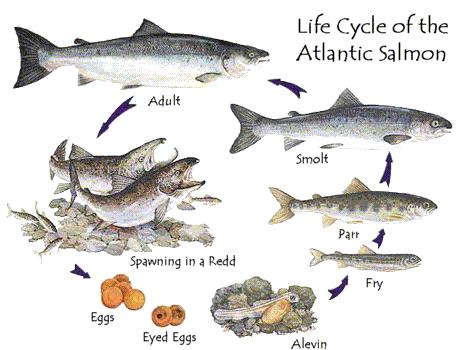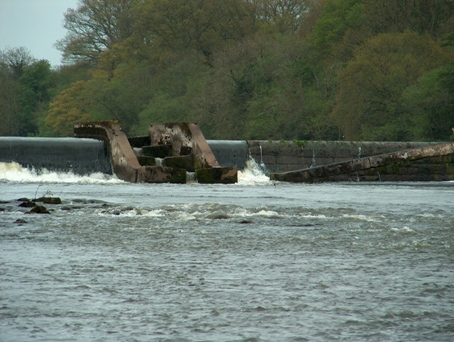Salmon Life cycle
Also in this Section:
The life of the Moyola salmon is an extraordinary journey involving hundreds of miles and countless waterfalls to scale before returning to the babbling streams of the Moyola at the foot of the Sperrins.
It is in late autumn that the life cycle of the salmo salar, the wild Atlantic salmon begins, with the cock fish (male parent) fertilising the thousands of eggs which the female has laid in a "REDD" or hollow of fine gravel at the top of the river near its source. The parent fish, now called 'kelts', cover up the eggs and drift back down- stream and back out to sea.

The eggs or OVA remain in the gravel for about five months, before hatching out into alevins. Having survived on the yolk sacs of their eggs, the baby fish (now called fry) start their lives by moving into the river, feeding on the tiny organisms that live in the river. With the constant threat of predatory fish and birds as well as flooding, about a quarter of the original hatch will not survive.
The fry that have survived grow to become three or four inch long parr and then continue to live in the river for two to three years, feeding on the tiny organisms that live in the river, before becoming Smolts and going out to sea in spring. Some Smolts stay close to the shore, living on the many sprats and sand eel and then return to the river as grilse after about a year, weighing several pounds. Other Smolts will travel further from the river, traveling thousands of miles across the Atlantic to the feeding grounds of south east Greenland and Iceland.
Having spent two or more winters at sea the adult salmon, of which only a small percentage will have survived, start their return journey home to the Moyola water to spawn for the first time. The urge for the salmon to return to the precise place of its birth is instinctive.

During this journey from sea through to the River Bann and Lough Neagh they will encounter otters, seals, sea birds, wild mink and predatory birds. Another major threat posed to them is man, as many are caught by the deep sea fishing nets or killed by pollution. If they surpass all these threats they now face their final challenge.
Salmon can be seen hurling themselves up the weirs of Moyola in a bid to reach their home.
The salmon require tremendous power to leap and they develop what scientists call "burst speed". This requires using anaerobic muscles rather than aerobic which is used for swimming, which can contract quickly and generate intense bursts of power, lasting only a few seconds and propelling themselves forward at incredible speeds, which can be up to eight meters per second.

